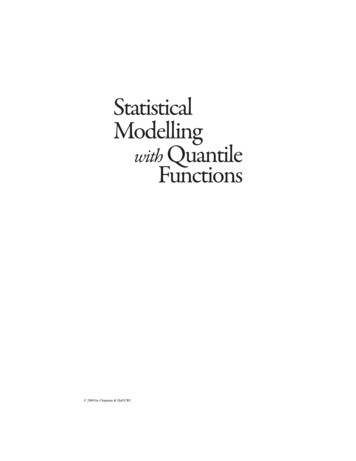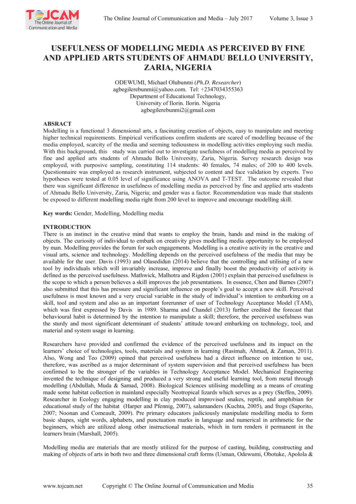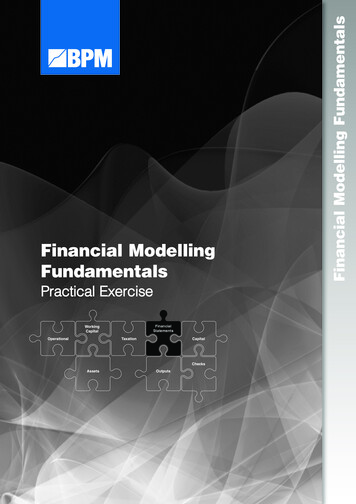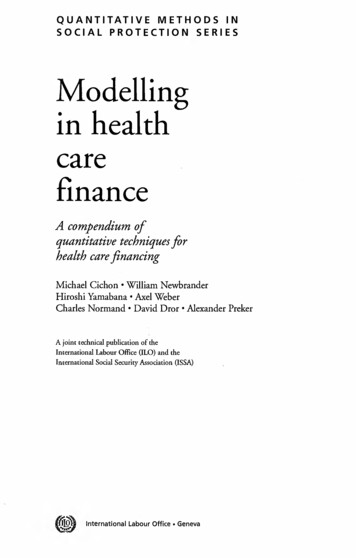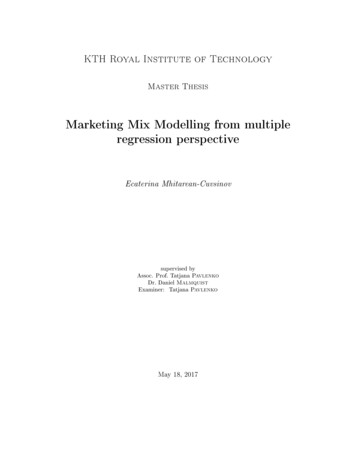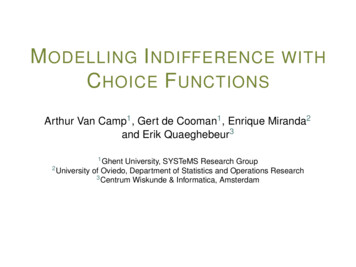
Transcription
M ODELLING I NDIFFERENCE WITHC HOICE F UNCTIONSArthur Van Camp1 , Gert de Cooman1 , Enrique Miranda2and Erik Quaeghebeur32 University1 Ghent University, SYSTeMS Research Groupof Oviedo, Department of Statistics and Operations Research3 Centrum Wiskunde & Informatica, Amsterdam
We want to modelindifferencewith choice functions.
We want to modelindifferencewith choice functions.Indifference- reduces the complexity,- allows for modelling symmetry.
Exchangeability is an example of both aspects.In [De Cooman & Quaeghebeur 2010, Exchangeability and sets ofdesirable gambles]: exchangeability for sets of desirable gambles.
Exchangeability is an example of both aspects.In [De Cooman & Quaeghebeur 2010, Exchangeability and sets ofdesirable gambles]: exchangeability for sets of desirable gambles.Sets of desirable gambles are very successful imprecise models.
Why choice functions?HX {H, T}T
Why choice functions?fair coinHTp(T) X {H, T}12 p(H)
Why choice functions?coin with identical sides of unknown typeHTpHX {H, T}(1pH (x) 0pTif x Hif x T(0pT (x) 1if x Hif x T
Why choice functions?coin with identical sides of unknown typeX {H, T}HTpHpTSuch an assessment cannot be modelledusing sets of desirable gambles!
Why choice functions?coin with identical sides of unknown typeX {H, T}HTpHpTSuch an assessment cannot be modelledusing sets of desirable gambles!HT
Choice functionsConsider a vector space Vand collect all its non-empty but finite subsets in Q(V ).A choice function C is a mapC : Q(V ) Q(V ) {0}/ : O 7 C(O) such that C(O) O.
IndifferenceThe options are equivalence classes, rather than gambles.
IndifferenceThe options are equivalence classes, rather than gambles.TH
IndifferenceThe options are equivalence classes, rather than gambles.TH
IndifferenceThe options are equivalence classes, rather than gambles.TH
IndifferenceWe call a choice function Con Q(V ) indifferent if there issome representing choice function C 0 on Q(V /I) (the equivalence classes of V ), meaning thatTHC(O) {u O : [u] C 0 (O/I)}.
IndifferenceWe call a choice function Con Q(V ) indifferent if there issome representing choice function C 0 on Q(V /I) (the equivalence classes of V ), meaning thatTHC(O) {u O : [u] C 0 (O/I)}.C selects either all or none ofthe options in red, orange, andblue.
Remark the similarity!Choice functionsWe call a choice function Con Q(V ) indifferent if there issome representing choice function C 0 on Q(V /I) (the equivalence classes of V ), meaning thatC(O) {u O : [u] C 0 (O/I)}.
Remark the similarity!Sets of desirable optionsChoice functionsA set of desirable options D Vis indifferent if and only if thereis some representing set of desirable options D 0 V /I of equivalence classes, meaning thatWe call a choice function Con Q(V ) indifferent if there issome representing choice function C 0 on Q(V /I) (the equivalence classes of V ), meaning thatD {u : [u] D 0 }.C(O) {u O : [u] C 0 (O/I)}.
Some propertiesA choice function C on Q(V ) indifferent if there is some representingchoice function C 0 on the equivalence classes of V , meaning thatC(O) {u O : [u] C 0 (O/I)}.
Some propertiesA choice function C on Q(V ) indifferent if there is some representingchoice function C 0 on the equivalence classes of V , meaning thatC(O) {u O : [u] C 0 (O/I)}.The representing choice function C 0 is unique and given byC 0 (O/I) C(O)/I for all O in Q(V )
Some propertiesA choice function C on Q(V ) indifferent if there is some representingchoice function C 0 on the equivalence classes of V , meaning thatC(O) {u O : [u] C 0 (O/I)}.The representing choice function C 0 is unique and given byC 0 (O/I) C(O)/I for all O in Q(V )C is coherent if and only if C 0 is coherent.
Some propertiesA choice function C on Q(V ) indifferent if there is some representingchoice function C 0 on the equivalence classes of V , meaning thatC(O) {u O : [u] C 0 (O/I)}.The representing choice function C 0 is unique and given byC 0 (O/I) C(O)/I for all O in Q(V )C is coherent if and only if C 0 is coherent.Indifference is preserved under arbitrary infima.
M ODELLING I NDIFFERENCEC HOICE F UNCTIONSWITHArthur Van Camp, Gert de Cooman, Enrique Miranda and Erik Quaeghebeur3. I NDIFFERENCE1. I NTRODUCTIONW HAT ? We investigate how to model indifference with choice functions.W HY INDIFFERENCE ?- Adding indifference to the picture typically reduces the complexity of the modelling effort.- Also, knowing how to model indifference opens up a path towards modelling symmetry, which hasmany important practical applications.Exchangeability is an example of both aspects. Our treatment here lays the foundation for dealingwith, say, exchangeability for choice functions.W HY CHOICE FUNCTIONS ? The beliefs about a random variable may, in an already quite generalsetting, be expressed using a set of desirable options (gambles). There exists a theory of indifferencefor sets of desirable options. However, such sets of desirable options might not be expressiveenough, as is shown in the next example.We flip a coin with identical sides of unknown type: either twice heads or twice tails.? ? ? ?XHT Hp(H) p(T) 1/2X {H, T}T Hp ( H ) 1, p ( T ) 0T Hp ( H ) 0, p ( T ) 1There is no set of desirable options that expresses this elementary belief. What we want is a more expressive model that canrepresent the stated belief, being an XOR statement. This beliefmodel should resemble the situation depicted on the right.TvacuousH2. C OHERENT CHOICE FUNCTIONSV ECTOR SPACE Consider a vector space V , consisting of options. We assume that V is equippedwith a given vector ordering , meaning that - is a partial order ( is reflexive, antisymmetric, and transitive);- satisfies u1 u2 λ u1 v λ u2 v for all u1, u2 and v in V and λ in R.With , we associate the strict partial ordering as u v (u v and u 6 v) for all u and v in V .For any O V , we let CH(O ) be its convex hull.We define Q P (V ) as the collection of non-empty but finite subsets of V .A choice function C is a mapC : Q Q {0}/ : O 7 C (O ) such that C (O ) O.R ATIONALITY AXIOMS We call a choice function C on Q (V ) coherent if for all O, O1, O2 in Q (V ),u, v in V and λ in R 0:C1. C(O ) 6 0/ ;[non-emptiness]C2. if u v then {v} C({u, v});[dominance]C3. a. if C(O2 ) O2 \ O1 and O1 O2 O then C(O ) O \ O1;[Sen’s α ]b. if C(O2 ) O1 and O O2 \ O1 then C(O2 \ O ) O1;[Aizerman]C4. a. if O1 C(O2 ) then λ O1 C(λ O2 );[scaling invariance]b. if O1 C(O2 ) then O1 {u} C(O2 {u});[independence]C5. if O CH({u, v}) then {u, v} C(O {u, v}) 6 0/ .[sticking to extremes]T HE ‘ ISNOT MORE INFORMATIVE THAN ’ RELATIONI NDIFFERENCE AND DESIRABILITY Given aset of desirable options D and a coherent setof indifferent options I, we call D compatiblewith I ifD I D.Elements of D/I can be identifiedQ UOTIENT SPACE We can collect all options that areindifferent to an option u in V into the equivalence classwith elements on this axis.T[u] : {v V : v u I} {u} I.DThe set of all these equivalence classes is the quotientspace V /I : {[u] : u V }, which is a vector spacewith vector orderingGiven two choice functions C1 and C2,C1 is not more informative than C2 ( O Q )(C1 (O ) C2 (O )).For a collection C of coherent choice functions, its infimum is the coherent choice function given byS(inf C )(O ) : C (O ) for all O in Q .C ONNECTION WITH SETS OF DESIRABLE OPTIONS Choice functions are essentially non-pairwisecomparisons of options. Therefore, we can associated a single coherent set of desirable options witha coherent choice function C byHfor all [u] and [v] in V /I.I DC u V : {u} C({0, u}) .ANWe give an alternative characterisation of indifference:INTERESTING CHARACTERISATIONProposition. A set of desirable options D V is compatible with a coherent set of indifferent options I ifand only if there is some ( representing) set of desirable options D0 V /I such that D {u : [u] D0} S 0D . Moreover, the representing set of desirable options is unique and given by D0 D/I : {[u] : u D}.Finally, D is coherent if and only if D/I is.I NDIFFERENCE AND CHOICE FUNCTIONS We use the same idea as for desirability.We call a choice function C on Q (V ) compatible with a coherent set of indifferent options I if there is arepresenting choice function C0 on Q (V /I) such thatC(O ) {u O : [u] C0 (O/I)} for all O in Q (V ).Proposition. For any choice function C on Q (V ) that is compatible with some coherent set of indifferentoptions I, the unique representing choice function C/I on Q (V /I) is given by C/I(O/I) : C(O )/I forSall O in Q (V ). Hence also C(O ) O C/I(O/I) for all O in Q (V ). Finally, C is coherent if andonly C/I is.Properties:- Indifference is preserved under arbitrary infima.- Given a coherent choice function C that is compatible with I, then DC is also compatible with I.- Given a coherent set of desirable options D that is compatible with I, then CD is also compatible with I.E XAMPLEConsider the possibility space X : {a, b, c} and the vector space V RX R3. We want to expressindifference between a and b, or in other words between I{a} and I{b}, where I{a} : (1, 0, 0) andI{b} : (0, 1, 0). What is the most conservative choice function C compatible with this assessment?Set of indifferent options:[u] {u} I {v R3 : E1 (u) E1 (v) and E2 (u) E2 (v)}.dim(R3 /I) 2.Vector ordering:[u] [v] ( λ R)u v λ (I{a} I{b} ) ( λ R)(ua va λ , ub vb λ and uc vc ) (E1 (u) E1 (v) and E2 (u) E2 (v))ucD- / D;- / D;- / D. / CD ({ , , , }) since D. / CD ({ , , , }) since D. in this two-dimensionalprojection along I on this plane.uc[v]ua ub-1(1, 1)-2-1v0 ( 32 , 1, 12 )ubw(1, 1, 31 )( 12 , 12 )(0, 0)11(2, 3 )-1ua[w][v0 ]v(1, 0, 1) CD ({ , , , }) sinceHR3 /I is the usual onevector spaceOptions in R3 /I can be identified with its[ w0 ] CD ({ , , , }) since 2The vector ordering on-21 ub1-12w0 ( 32 , 12 , 32 )( 1, 32 ) -2-1-1a2T 1-2I{a} u I{b} 1-2 CD (O ) u O : ( v O )v u / D for all O in Q .- / D;- / D;- / D.uc set of indifferent options2 I {(λ , λ , 0) : λ R}I {λ (I{a} I{b} ) : λ R} {(λ , λ , 0) : λ R} {u R3 : E1 (u) E2 (u) 0}with E1 and E2 the expectations associated with the mass functions p1 : (1/2, 1/2, 0) and p2 : (0, 0, 1).Equivalence class:Conversely, given a coherent set of desirable options D, there are multiple associated coherentchoice functions, and the least informative one is given by D0 D/I[u] [v] ( w V )u v wTSets of desirable options allow only for binary comparison between gambles, whereas choicefunctions determine “more than binary” comparison.D EFINITIONS ET OF INDIFFERENT OPTIONS Like a subject’s set of desirable options D—the options he strictly prefersto zero—we collect the options that he considers to be equivalent to zero in his set of indifferent options. Aset of indifferent options I is simply a subset of V .We call a set of indifferent options I coherent if for all u, vin V and λ in R:I1. 0 I;I2. if u V 0 V 0 then u / I;[non-triviality]I3. if u I then λ u I;[scaling]I4. if u, v I then u v I.[combination]2-212The vacuous—least informative—choice function C/I on R3 /I selects the undominatedoptions: C({[v], [v0 ], [w], [w0 ]}) {[v], [w], [w0 ]}.That means that the most conservative choicefunction C we are looking for (the one on R3),has the following behaviour on those four options:C({v, v0, w, w0}) {v, w, w0}.
3Centrum Wiskunde & Informatica, Amsterdam. We want to model indifference with choice functions. Indifference-reduces thecomplexity,-allows for modellingsymmetry. We want to model . We call a choice function ConQ(V)compatiblewith a coherent set of indifferent options Iif there is a representingchoice functionC0onQ(V/I) .

